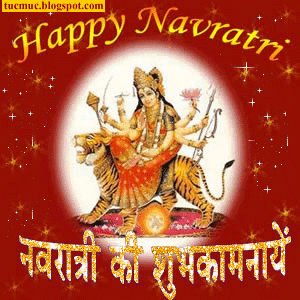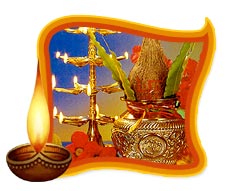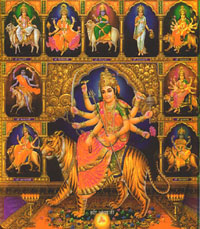


 |
 |
 |
|
|
 Sep 30 2008 to Oct 7 2008 Ashami : Oct 8,2008 Ram navmi : Oct 9, 2008 Dussehra : October 10,2008 |
|
||||||||||||||||||||
|
Navratras are observed twice a year, once in Chaitra, preceding Rama Navami, and then in Ashvin (September - October) preceding Dussehra. The nine-day Navratra commences with the new moon of Ashvin and terminates with Mahanavami, on the ninth lunar day of the bright half of the month. During these nine days, devotees keep strict fast and Durga is worshipped. The style of observing Navratra in different parts of the country may be different, but its sole aim is to propitiate Mother Durga and to seek her blessings
Navratri, the festival of
nights, lasts for 9 days with three days each devoted to worship of Ma
Durga, the Goddess of Valor, Ma Lakshmi, the Goddess of Wealth and Ma
Saraswati, the Goddess of Knowledge. During the nine days of Navratri,
feasting and fasting take precedence over all normal daily activities
amongst the Hindus. Evenings give rise to the religious dances in order to
worship Goddess Durga Maa. |
|||||||||||||||||||||||
 |
 |
 |
|
| Nine different manifestations of Durga are worshipped during Navratri they are | |||
|
|||
DISCLAIMER This site is Non-Profitable & Non-Commercial site developed by devotees of Mata Jhandewali. The information provided here is for reference only. Therefore, all E-mails sent to us do not get to the Jhandewalan Temple (Badri Bhakat Trust). Donations and offerings to Maa Jhandewali / Jhandewalimata Trust cannot be done through this website, kindly contact temple society as per contact details for necessary action. We welcome your suggestions to make this site truly comprehensive for benefit of devotees around the world. ©2005 Jhandewalimata.com All Right's Reserved |
|||